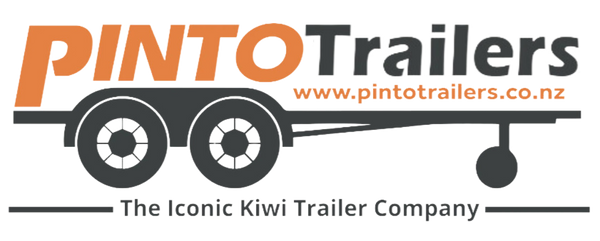Here’s a helpful guide of standard trailer components, their descriptions and how to use them.
What is a Coupling? - “the act of bringing or coming together” the coupling attaches the trailer to the tow ball. Couplings come in many different sizes, in New Zealand the two standard sizes of tow ball, 1 ⅞ and 50mm, it is important that your tow ball and coupling match and are in good condition. Pinto tandem braked trailers, equipment trailers, car transporters and flat deck trailers all come with a multi fit coupling as standard, for all other trailers this is an optional upgrade.
To attach your coupling, lift the handle to open the locking mechanism, place the coupling over your tow ball and carefully lower down, release the handle to lock in place. Once you attach your coupling to your tow ball you must always check it is locked in place and the safety pin is in place where fitted.
What is a Safety chain? - The chain next to the coupling is your safety chain, imagine if your coupling or tow ball fails, the safety chain ensures that your trailer remains attached to your vehicle and must be used at all times when using your trailer. Simply unscrew the U-bolt and attach to the hole on the ball mount next to the tow ball. For trailers with a GVM over 2000kg dual safety chains must be fitted and it is best practice to cross the safety chains when connecting them to your vehicle.
What is a Light cable? - All road trailers will have lights and they work by plugging the light cable into the socket on the back of your vehicle, when you brake, indicate or turn on your lights, so will your trailer. It is very important to keep the lead off the ground to avoid crushing the cable and/or the pins. Check your pins and cable regularly for any sign of damage as you should replace it immediately if there are any wires showing or broken pins. Once you have attached your tailer and light cable, it is good practice to check all lights before driving away.
What is a Jockey wheel? - This is a retractable wheel on the front end of your drawbar that folds up and down. When folded down, the handle at the top can be turned to adjust the height of the jockey wheel. The jockey wheel is used to help ‘jockey’ your trailer into place and stabilise your trailer when loading and unloading, it can also help keep your load level when not attached to your vehicle. Your jockey wheel should always be folded away and locked in place after attaching the trailer to your vehicle.
What is a Drawbar? - The drawbar is the bar that comes from the deck of the trailer and out to the coupling. Drawbars can be all sizes and be triangular or single bar. It is important the drawbar maintains its strength and structural integrity. If you are ever in an accident or overload your trailer, carefully check your drawbar for any damage, most mechanics can do a thorough check if you are unsure. If you have an aging trailer, you should also be checking for any signs of rust and fix it immediately.
What is a Stabiliser? - Stabilisers are used to stabilise or level your trailer when it is detached from your vehicle. Often fitted to display trailers, bbq trailers, box body and some equipment trailers, there is usually one pair on the rear of your trailer and they are mostly used in combination with a jockey wheel, however a pair can also be used on the front of the trailer too. Pinto’s trailer stabilisers are fitted with a bright red handle, simply pull these out, twist your stabiliser around toward the ground then push your handle back in to lock the system. To put the stabilisers away, simply reverse this process. Like your jockey wheel, always check these are in the locked position before moving your trailer.
What is an Axle? - An axle is the rod or shaft that rotates your wheels and attaches your wheels to your trailer. The axle supports the weight of the trailer and its load and is central to the structural strength of your trailer, therefore it's important to understand your towing capacity when building your trailer; sometimes we may need to upgrade your axle(s) to suit your towing needs. Axles come with bearings and hubs and with or without braking for your trailer and help to absorb the weight and forces when towing your trailer. Pinto’s trailers come in single (1) axle and tandem (2) axle, and we recommend braked trailers for trailers 1750kg GVM and over.
Unlike cars and trucks, trailer axles work independently and do not connect to a drivetrain and steering. Steering comes from your pivot point at the tow ball and coupling.

